#buccopharyngeal
Text
En la entrada del vestuario, hago que mi novia se corra a chorros mojando el suelo
My GF Fucking Hidden Cam
Amateur Latina cutie in glasses blows cock
Sweltering hottie gets hot shaved pussy fucked by big cock
Angela White deepthroating a monster black cock
Young man secretly filmed changing wears teddy bear undies
Branquinha sensacional
gay indian hairy gunshot Sathish
LeWood MILF Big Tits and Big Clit Fucked Hard
Lustful vixen
#dispreads#coon's#hokku#buccopharyngeal#paterfamiliases#Afg#algometrically#reservable#Antilocapridae#ideogenous#hithertills#bulldozing#skiffling#erotomaniac#seawater#hydroxamic#Chaoan#underwage#thenardite#nonprovident
0 notes
Text
Sexy curvy teen loves a big hard cock
Hot Mass Effect and Lara Croft sex compilation tape
Petite lesbian fingers
German Wife Suprise His Husband with Young Teen in Threesome
Excited hooker gives a hawt blowjob and jerks off to finish
Japanese Femdom Youko Deep Facesitting
Indian college girl Sarita fucking with her bf for getting extra pleasure
Old men getting blowjobs at the gloryhole and anal gay teen extreme
MILF riding dildo
Rebolando na vara do negao
#isoscele#uncomeliness#weak-spiritedly#hypogyny#ADSR#medicophysics#laurustine#panoramically#self-improver#cloud-built#Tricholaena#alphanumerical#dispreads#coon's#hokku#buccopharyngeal#paterfamiliases#Afg#algometrically#reservable
0 notes
Text

Western Red-backed Salamander (Plethodon vehiculum), family Plethodontidae, western WA, USA
Salamanders in this family, Plethodontidae, do not have lungs and the family is referred to as the "lungless salamanders".
They absorb oxygen through the lining of the mouth and throat (buccopharyngeal respiration), as well as though their skin.
photograph by Izzy Edwards
265 notes
·
View notes
Text
Wet Beast Wednesday: tardigrades
Last week on Wet Beast Wednesday I covered the largest animals to ever exist on our planet. This week I'm going to pull a full 180 and cover the smallest animals yet on this series. Meet the tardigrade, the internet's favorite micro-animal the is said to be basically immortal. How true is that? Let's see.

(Image: an electron microscope image of a tardigrade. It looks a lot like a potato with eight stubby legs tipped with long claws. At the front is a small, circular mouth. It has no other discernable features. In the background are bits of plant matter that look like seaweed at this scale. End ID)
The tardigrades are 1,300 known species (and probably a lot of unknown ones too) in the phylum Tardigrada. They are also part of the superphylum Ecdysozoa, which are animals that grow by molting their outer cuticles or exoskeletons. In particular, the tardigrades are believed to be a sister group of the arthropods, the group that contains crustaceans, insects, isopods, and a lot of other things. Tardigrades are truly tiny, the largest species reaching a whopping 1.5 millimeters in length, though most species reach no more than 0.5 mm. They have round, segmented bodies with four pairs of legs that end in either claws or suction discs. The body segments consist of a head, three body segments with a pair of legs each, and a caudal segment with the final pair of legs. The first three legs are used for movement while the final pair points backwards and is used for grabbing onto substrate. All of the body segments except for the final one correspond to segments found in the head section of insects. Tardigrades are missing many hox genes, genes that direct the body plan during development. Their ancestors may have had a body plan more similar to insects, but the loss of the hox genes has compressed them into walking heads with a bit of butt. The mouth is tubular and sucks in food. In the mouth are stylets, needle-like structures used to pierce food objects. Once food is drawn into the mouth, a structure called the buccopharyngeal apparatus activates. This is a combination of spines and muscle that acts like an inner jaw that pulls food into the digestive tract. The buccopharyngeal apparatus is distinct enough to be used as a major identifying feature between species. Tardigrades are translucent and many images you've seen of them have false color to show the details or are 3D models based on scanning electron microscope imagery of them. Tardigrades molt their exoskeletons multiple times (up to 12) during their lifecycle. Some species are unable to poop normally and instead all their waste is discarded during the molt. It was formerly believed that tardigrades could exchange genes with each other without mating, a process called horizontal gene transfer that is seen in bacteria, archaea, and other micro-organisms. It has since been discovered that while still capable of horizontal gene transfer, it is quite a bit rarer in tardigrades than we thought.
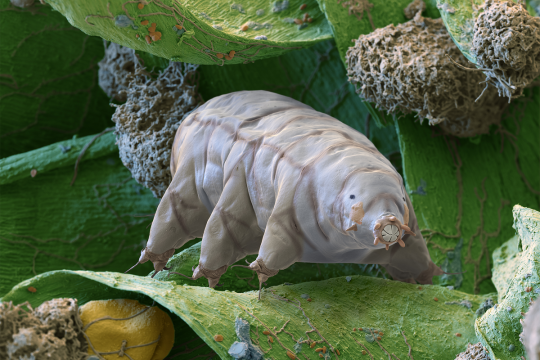
(Image: an electron microscope image of a tardigrade standing on a bit of plant matter. This one has a closed mouth with a ring of triangular tooth-like structures. It also has two simple eyes that look like black dots. End ID)
The name "tardigrade" means "slow walker", which is fitting as, despite their eight legs, tardigrades have a slow and awkward gait. This is the result of their legs being unjointed, only able to pivot at their connection to the body. Their gait has been compared to that of bears, hence why they are often called water bears and their discoverer, Johann August Ephraim Goeze, called them "kleiner wasserbär", meaning "little water bear". Tardigrades are found worldwide and have inhabited virtually every habitat, from the tops of mountains to the deep sea, from hot springs to the antarctic, from freshwater to saltwater. The one thing they have in common is a need to stay wet. Tardigrades can survive out of water as long as they can stay moist and are often found in mosses, hence another common name: moss piglets. The majority either eat plants or bacteria, but some will feed on smaller tardigrades or other micro-animals. Their famous survivability makes it easy for tardigrades or their eggs to be carried to new habitats by larger animals or other phenomena. Tardigrades are one of the first micro-animals to colonize a new habitat and they are a pioneer species, the first species to colonize a new environment and whose presence makes that environment fore suitable for other species to follow. Tardigrades are a major food source to other micro-animals and larger organisms. Most species have distinct males and females, though a few reproduce through parthenogenesis. In most cases, molting female will lay her eggs in her shed cuticle and males will them fertilize them. Other species have a form of internal reproduction. Males and females will court each other before mating and females will usually allow multiple males to fertilize her eggs. Female tardigrades are typically larger and more abundant than males. Eggs can take up to 14 days (species dependent) before hatching. All tardigrades of the same species have the exact same number of cells as each other. They are also born with the same number of cells they will have as an adult. Their growth is driven by enlargement of the existing cells rather than cellular reproduction making new cells. The lifespan ranges between a few months to a few years, depending on species.

(Image: a color photo of a tardigrade. It is a pale, translucent white, making it hard to make out details. Its body is curved, with the front end pointing at the camera. It has two simple eyes. End ID)
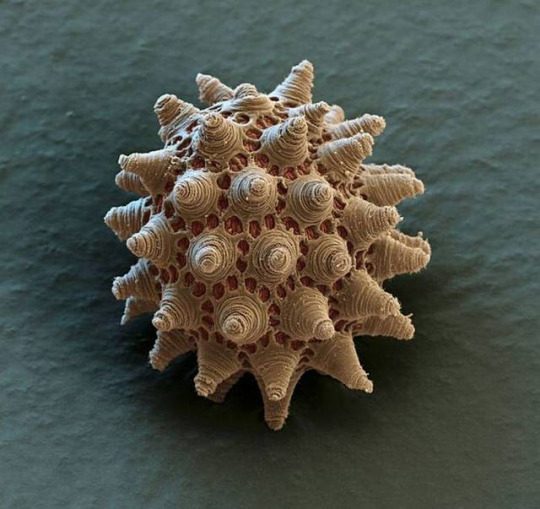
(Image: an electron microscope image of a tardigrade egg. It is round but covered in small pores and conical structures. End ID)
The most famous feature of tardigrades is their legendary durability. It is commonly said that tardigrades can survive just about anything (except for the things that are actually trying to kill them. They are prey to a lot of species after all). Among the things they can survive is extreme heat, extreme cold, dehydration, extremely high and low pressure, exposure to ionizing radiation (that's the scary kind), low oxygen environments, environmental toxins, heavy impacts, and the vacuum of fucking space. While the can survive in extreme conditions, tardigrades are not considered extremophiles. True extremophiles thrive in extreme environments and are negatively impacted by leaving them. Tardigrades can survive in extreme environments, but are negatively impacted and can't survive as well there as they can in less extreme places. The main trait that has allowed tardigrades to survive all five mass extinctions in history is cryptobiosis. Cryptobiosis is the rare ability for an animal to enter a state of dormancy where their metabolic processes come to an almost complete stop. While in cryptobiosis, metabolic activity drops to 0.01% normal and water content drops to 1% normal. In this state, the tardigrade is called a tun. Tardigrades usually enter cryptobiosis in response to arid conditions. One experiment showed that a species of tardigrade could last for at least 30 years in this state and return to normal lifestyle functions when exposed to water. Tardigrades will also enter cryptobiosis in response to low oxygen, toxic chemical exposure, increased or decreased temperature, and excessive salt content in the water. Tardigrades also show extreme resistance to both high and low pressure. They can live in 0 atmospheres of pressure and some species can survive up to 6,000 atmospheres, more than double the pressure at the bottom of the Marianas trench. More interesting is their ability to survive dangerous radiation. They can survive 1,000 times the dose of gamma radiation that humans can. Early tests focused on tardigrades in cryptobiosis and concluded that the extremely low water content of a cryptobiotic tardigrade doesn't leave much opportunity for the radiation to react with the animal. However it was later found that active and fully hydrated tardigrades are still considerably resistant to radiation. Studies into this resistance indicate that tardigrades can very efficiently repair damaged DNA and have unique proteins called Dsup that provides additional protection. Dsup introduced to human cells has provided additional protection against x-rays.
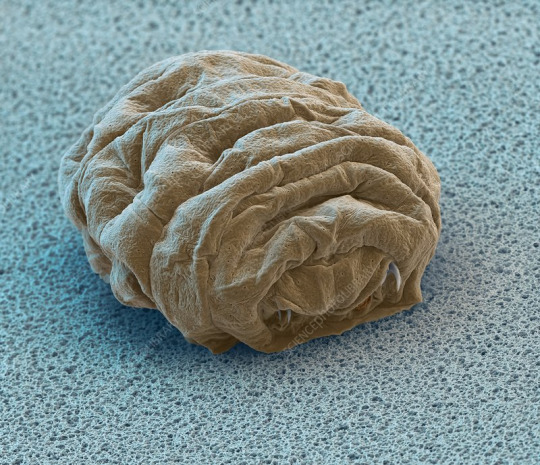
(Image: an electron microscope image of a tun - a tardigrade in cryptobiosis. It is smaller and very wrinkly, with the legs and mouth retracted into the body. End ID)
Tardigrades were the first animals to be exposed to the vacuum of space. They were exposed for 10 days, some in a state of cryptobiosis at the time of exposure and some still active. It was found that they were able to survive the vacuum when shielded from the sun's ultraviolet radiation, with those already in cryptobiosis doing better. Upon being rehydrated, many were able to resume normal life functions and successfully reproduce, though others died after being rehydrated. Those that were exposed to UV radiation fared much worse, with only a few hydrated individuals surviving. The individuals in cryptobiosis had a lower survival rate when exposed to UV than those not exposed to UV and were less successful at reproducing afterwards. Studies of tardigrade's space survival abilities and resistance to radiation could go a long way in helping human space travel. One of the largest dangers of space travel is that space is full of nasty radiation from the sun that Earth's magnetic field protects us from. Some scientists speculate about the possibility of accidentally seeding other planets or moons with tardigrades or other space-resistant organisms. This is a problem because introducing Earth life to other world has the potential to damage any native ecosystems and if we find life in space in the future we don't want to have to figure out if it's something we accidentally put there. While tardigrades could likely survive on other planets, they would eventually die without a food source. Some sources reported that tardigrades may have colonized the moon after an experiment with them crashed. Unfortunately, the moon is not crawling with tardigrades now. It's way too dry for them to exit cryptobiosis even if they survived the crash, which they probably didn't.
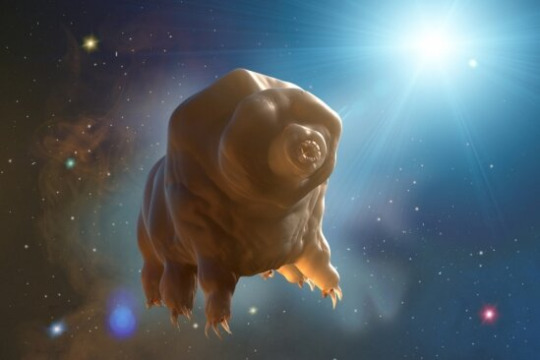
(Image: art of a tardigrade floating in the vacuum of space. End ID. Source: University of California - Santa Barbara)
#wet beast wednesday#tardigrade#water bear#moss piglet#micro animal#microbiology#marine biology#biology#zoology#ecology#animal facts#informative#science#space#astrobiology#radiation#cryptobiosis#tun#image described
155 notes
·
View notes
Text
might be a long shot but is anyone following me really autistic about turtles or just really into them and want to talk about them with me. i mean real turtles like actual real life reptiles not the cartoons. I'm having trouble finding opensource resources that go into detail on buccopharyngeal respiration in softshells and i don't go to college
#this blog is old so theres like 3k followers but i feel like only maybe 5 or 10% are active#when i went to clean the beaches & talked to the zoologist organizing the event i asked if she knew any good resorces and she was just like#well. have you tried google scholar#so.
12 notes
·
View notes
Text
Deep Cervical Fascia/ Fascia Colli
Deep Cervical Fascia/ Fascia Colli
The deep fascia of the neck is condensed to form the following layers:
1. Investing layer
2. Pretracheal layer
3. Prevertebral layer
4. Carotid sheath
5. Buccopharyngeal fascia
6. Pharyngobasilar fascia.
INVESTING LAYER
It lies deep to the platysma,
surrounds the neck like a collar.
It forms the roof of the posterior triangle of the neck
Attachments
Superiorly :
a. External…
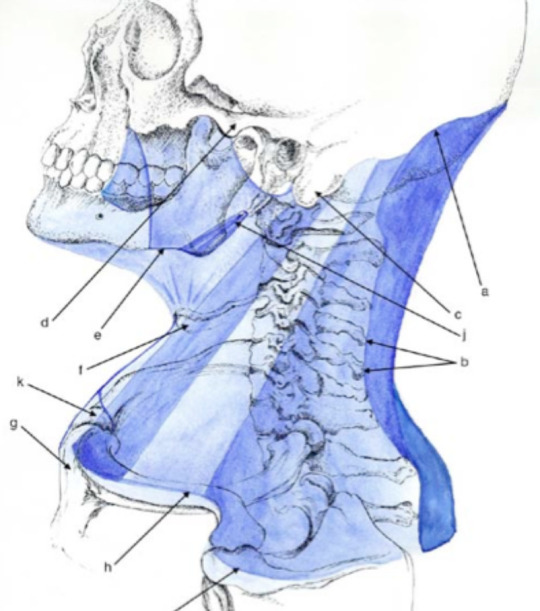
View On WordPress
#carotid sheath#deep fascia#fascia colli#investing layer of deep cervical fascia#pretracheal fascia#prevertebral fascia
0 notes
Text
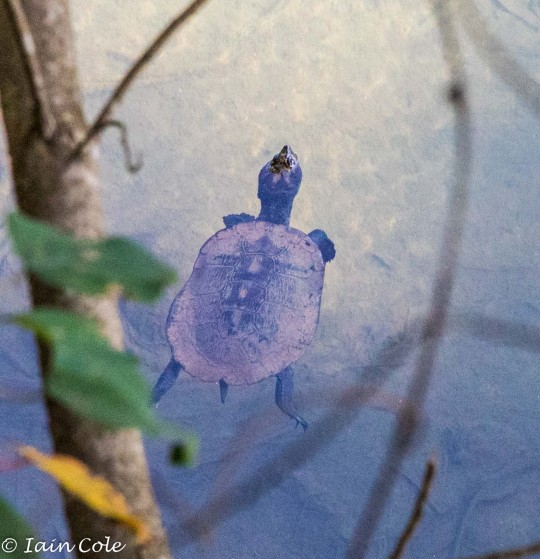


Saw-shelled turtle, Lake Eacham
(On my travels)
These turtles are literally bottom breathers. They are able to obtain oxygen from water through skin, cloaca and buccopharyngeal cavity which enables them to stay underwater longer.
#original photographers#nature photography#wildlife photography#Turtle#Saw-shelled turtle#Lake Eacham
50 notes
·
View notes
Text
'Once-in-a generation' tardigrade fossil discovery reveals new species in 16-million-year-old amber
https://sciencespies.com/nature/once-in-a-generation-tardigrade-fossil-discovery-reveals-new-species-in-16-million-year-old-amber/
'Once-in-a generation' tardigrade fossil discovery reveals new species in 16-million-year-old amber
They’ve famously survived the vacuum of space, and even returned to life after being frozen for decades in Antarctic moss. But as hard as it is to kill the bizarre microscopic animal, the tardigrade, it’s harder to find one fossilized. In fact, only two have ever been discovered and formally named — until now.
In in the Proceedings of the Royal Society B, lead researchers at New Jersey Institute of Technology and Harvard University have described just the third fossil tardigrade on record — a new genus and species Paradoryphoribius chronocaribbeus gen. et sp. nov. (Pdo. chronocaribbeus), which is fully preserved in 16-million-year-old Dominican amber from the Miocene.
Measured at just over half a millimeter, the specimen has been identified as a relative of the modern living tardigrade superfamily, Isohypsibioidea, and represents the first tardigrade fossil recovered from the Cenozoic, the current geological era beginning 66 million years ago.
Researchers say the pristine specimen is the best-imaged fossil tardigrade to date — capturing micron-level details of the eight-legged invertebrate’s mouthparts and needle-like claws 20-30 times finer than a human hair. The new fossilis deposited at the American Museum of Natural History Division of Invertebrate of Zoology.
“The discovery of a fossil tardigrade is truly a once-in-a-generation event,” said Phil Barden, senior author of the study and assistant professor of biology at New Jersey Institute of Technology. “What is so remarkable is that tardigrades are a ubiquitous ancient lineage that has seen it all on Earth, from the fall of the dinosaurs to the rise of terrestrial colonization of plants. Yet, they are like a ghost lineage for paleontologists with almost no fossil record. Finding any tardigrade fossil remains is an exciting moment where we can empirically see their progression through Earth history.”
“At first glance, this fossil appears similar to modern tardigrades due to its relatively simple external morphology,” said Marc A. Mapalo, lead author of the study and graduate student at Harvard’s Department of Organismic and Evolutionary Biology. “However, for the first time, we’ve visualized the internal anatomy of the foregut in a tardigrade fossil and found combinations of characters in this specimen that we don’t see in living organisms now. Not only does this allow us to place this tardigrade in a new genus, but we can now explore evolutionary changes this group of organisms experienced over millions of years.”
Tardigrades, or water bears, are renowned for their unusual appearance and self-preservation abilities — certain species are known to survive extreme conditions by curling into a dehydrated ball and entering a state of suspended animation where their metabolism is virtually paused, known as cryptobiosis.
advertisement
Rare tardigrade fossil finds such as Pdo. chronocaribbeus, the team suggests, could provide new molecular estimates that offer fresh insight into major evolutionary events that have shaped the more than 1,300 species found across the planet today, such as the miniaturization of their body plan into one ofEarth’s smallest-known animals with legs.
Perhaps the greatest challenge in unearthing tardigrade fossils, however, is their size.
“It’s a faint speck in amber,” said Barden. “In fact, Pdo. chronocaribbeus was originally an inclusion hidden in the corner of an amber piece with three different ant species that our lab had been studying, and it wasn’t spotted for months.”
Barden says tardigrades’ microscopic non-biomineralized bodies are also uniquely suited to preservation in amber derived from plant resin, which is capable of safely enveloping and preserving organisms as minute as water bears and even individual bacterium.
“This particular mode of fossilization helps explain the patchy fossil record,” explained Barden. “Fossil amber with arthropods trapped inside is only known from 230 million years ago to the present … that’s less than half of the history of tardigrades.”
Placing Pdo. chronocaribbeus on the Tardigrade Tree
advertisement
While it is estimated that tardigrades diverged from other panarthropod lineages before the Cambrian 540 million years ago, only two definitive tardigrade fossils have formally been described, both from Cretaceous fossil deposits in North America.
To explore Pdo. chronocaribbeus andits place on the tardigrade ancestral tree, Mapalo used high-powered laser confocal fluorescence microscopy to finely image the specimen. The team then compared it across a range of morphological features associated with major tardigrade groups alive today — including key identifiers such as body surface, claws, buccopharyngeal apparatus and egg morphology.
“The fact that we had to rely on imaging techniques usually reserved for cellular and molecular biology shows how challenging it is to study fossil tardigrades,” said Javier Ortega-Hernandez, assistant professor of organismic and evolutionary biology at Harvard. “We hope that this work encourages colleagues to look more closely at their amber samples with similar techniques to better understand these cryptic organisms.”
The team’s analysis places Pdo. chronocaribbeus in one of three core classes of tardigrade, Eutardigadra, and makes it the first definitive fossil member of the superfamily called Isohypsibioidea — a diverse species that today inhabits aquatic and land environments and is typically characterized by their distinct claws that vary in size leg-to-leg.
The finding also puts a minimum age on the Isohypsibioidea family.
“We are just scratching the surface when it comes to understanding living tardigrade communities, especially in places like the Caribbean where they’ve not been surveyed,” said Barden. “This study provides a reminder that, for as little as we may have in the way of tardigrade fossils, we also know very little about the living species on our planet today.”
#Nature
1 note
·
View note
Photo
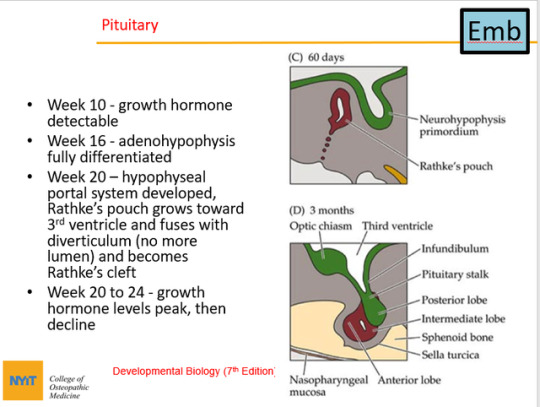
So basically, the pituitary gland forms from neural ectoderm (neurohypophysis), which descends from the brain to the roof of the mouth, and surface ectoderm (adenohypophysis), which comes from the roof of the mouth and moves superiorly. They fuse. So there are 2 cell types that make up the pituitary gland. Rathke’s pouch is the surface ectodeum of the stomodeum (mouth) that folds in.
Wikipedia:
In embryogenesis, Rathke’s pouch is an evagination at the roof of the developing mouth in front of the buccopharyngeal membrane. It gives rise to the anterior pituitary (adenohypophysis), a part of the endocrine system.
Rathke’s pouch, and therefore the anterior pituitary, is derived from ectoderm.
The pouch eventually loses its connection with the pharynx giving rise to the anterior pituitary. The anterior wall of Rathke’s pouch proliferates, filling most of the pouch to form pars distalis and pars tuberalis. The posterior wall forms pars intermedia.
1 note
·
View note
Text
Surgical Anatomy of the Foramen Jugular_Crimson Publishers
Surgical Anatomy of the Foramen Jugular by Behzad Saberi in Techniques in Neurosurgery & Neurology
https://crimsonpublishers.com/tnn/fulltext/TNN.000537.php

Foramen jugular is located in the posterior fossa lateral to the carotid canal. Petrous bone forms its anterior wall and occipital bone forms its posteromedial wall. Foramen jugular located about 5mm above the intracranial orifice of the hypoglossal canal, 23 mm to the apex of the mastoid tip and 15mm from tympanomastoid suture. Its direction has an anterior, lateral and inferior pattern. Foramen jugular divided anatomically into pars nervosa which contains inferior petrosal sinus, Jacobsen’s and glossopharyngeal nerves and pars vascularis which contains cranial nerves X and XI, Arnold’s nerve, jugular bulb, internal jugular vein and a branch of the ascending pharyngeal artery which would be its posterior meningeal branch. Hypoglossal nerve is located medial to the foramen jugular, vertebral artery is located inferior to that, mastoid segment of the facial nerve is in its lateral side and petrous part of the internal carotid artery located in its anteromedial side. There are some potential spaces along the foramen jugular which are buccopharyngeal fascia, superficial layer of the deep cervical fascia and prevertebral fascia.
For more open access journals in Crimson Publishers please click on link: https://crimsonpublishers.com/
For more articles in Journal of Neurosurgery please click on link: https://crimsonpublishers.com/tnn/
#crimsonpublishers#Crimson Publishers LLC#crimson publishers TNN#Crimson Publishers Journals#crimson publishers
0 notes
Photo

Buccopharyngeal fascia
Buccopharyngeal fascia Carotid sheath outlined in red Muscles of the pharynx and cheek Details Identifiers Latin Fascia buccopharyngea TA A04.1.04.010 A05.3.01.116 FMA 55078 Anatomical terminology [edit on Wikidata] The buccopharyngeal fascia is a fascia in the head. Parallel to the carotid sheath and along its medial aspect the pretracheal fascia gives off a thin lamina, the buccopharyngeal fascia, which closely invests the constrictor muscles of the pharynx and is continued forward from the constrictor pharyngis superior onto the buccinator. It is attached to the prevertebral layer by loose connective tissue only, and thus an easily distended space, the retropharyngeal space, is found between them.
More details Android, Windows
1 note
·
View note
Text
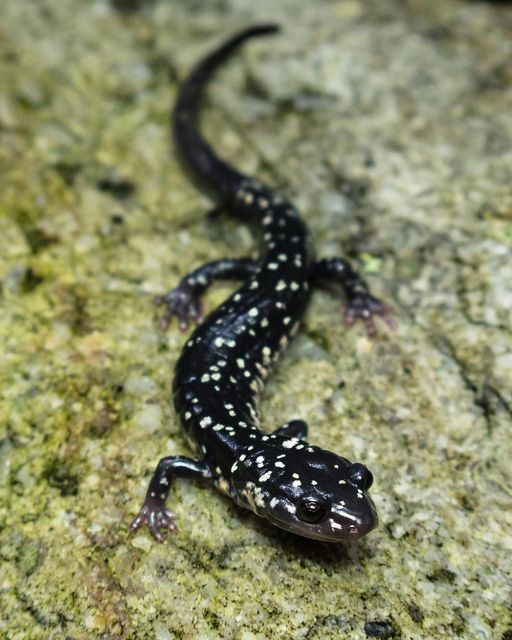
Northern Slimy Salamander (Plethodon glutinosus), family Plethodontidae, Maryland, USA
This species is in the Lungless Salamander family, Plethodontidae. The salamanders do not breathe with lungs, but instead absorb oxygen from the air through the skin and lining of the mouth (buccopharyngeal respiration).
photograph by Frankie Gebhard
204 notes
·
View notes
Text
Clarithromycin
Amniotic fluid enters both the gastrointestinal and respiratory tract following rupture of the buccopharyngeal membrane. In addition, a ventral ...
from Google Alert - gastrointestinal http://ift.tt/2pdMXN9
0 notes
Text
Development of pituitary gland and sympathetic nervous system
Development of pituitary gland and sympathetic nervous system
Pituitary gland Anterior lobe (adenohypophysis) Ectoderm – roof of stomodeum Forms diverticulum called Rathke’s pouch, which grows upwards from stomodeum infront of buccopharyngeal membrane End of 3rd month, loses connection with stomodeum and differentiates into; Pars distalis, Pars tuberalis and Pars intermedia Lumen gets obliterated Posterior lobe (neurohypophysis) Neural ectoderm – floor of…
View On WordPress
0 notes